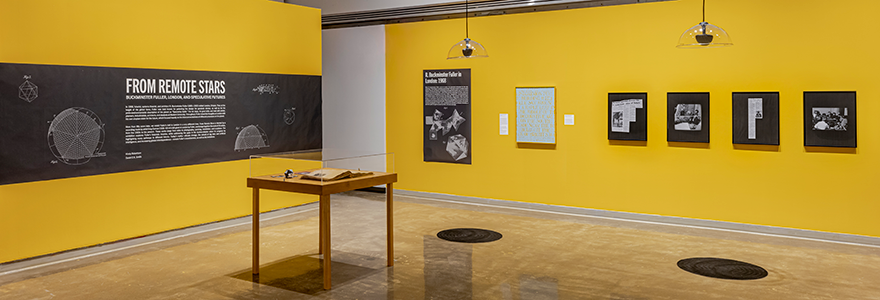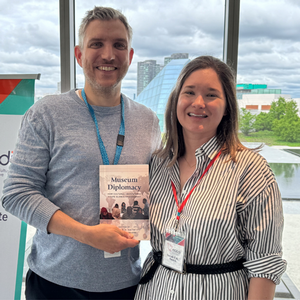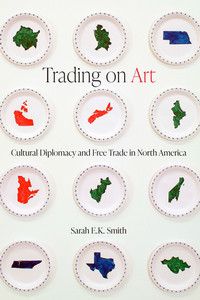Research
Contact Information
Research Officer
Chantal Lemire
clemire2@uwo.ca
519-661-2111x85383
FIMS & Nursing Building
Rm 4054
Assistant Dean Research
Isola Ajiferuke
iajiferu@uwo.ca
519-661-2111x81364
FIMS & Nursing Building
Rm 4025
Canada Research Chair

Get to know Canadian Research Chair Sarah E.K Smith
 Sarah E.K. Smith is an Associate Professor in the Faculty of Information and Media Studies and holds the Canada Research Chair in Art, Culture and Global Relations. A scholar and a curator, her research focuses on cultural diplomacy: how visual art is used by states and other actors to advance relationships in the international arena. Addressing art, exhibitions, and museums, Smith’s research provides a lens into how cultural institutions that showcase and exchange information, art, and visuals influence international relationships. Her efforts to prioritize engagement and collaboration with cultural practitioners are the focus of the Practitioner Media Lab, which she leads in FIMS.
Sarah E.K. Smith is an Associate Professor in the Faculty of Information and Media Studies and holds the Canada Research Chair in Art, Culture and Global Relations. A scholar and a curator, her research focuses on cultural diplomacy: how visual art is used by states and other actors to advance relationships in the international arena. Addressing art, exhibitions, and museums, Smith’s research provides a lens into how cultural institutions that showcase and exchange information, art, and visuals influence international relationships. Her efforts to prioritize engagement and collaboration with cultural practitioners are the focus of the Practitioner Media Lab, which she leads in FIMS.
 Smith is a founding member of the North American Cultural Diplomacy Initiative (NACDI). NACDI is a multi-disciplinary research network comprised of policymakers, academics, and practitioners. The group aims to expand conversations about the importance of cultural diplomacy and how it functions as a multi-directional and potentially activist practice.
Smith is a founding member of the North American Cultural Diplomacy Initiative (NACDI). NACDI is a multi-disciplinary research network comprised of policymakers, academics, and practitioners. The group aims to expand conversations about the importance of cultural diplomacy and how it functions as a multi-directional and potentially activist practice.
Her 2023 collection Museum Diplomacy: How Cultural Institutions Shape Global Engagement, co-edited with Sascha Priewe, recognizes the pivotal contributions of museums globally and asks how they can help to advance cross-cultural education and foster mutual understanding at a moment when we are beset by global challenges. Smith’s next book, Trading on Art: Cultural Diplomacy and Free Trade in North America, argues that visual art was vital to naturalizing the concept of North American economic integration following the free trade deals implemented near the end of the twentieth century.
As a scholar, Smith has a multi-modal practice that includes curating and research-creation. Her curatorial projects address contemporary issues ranging from surveillance to queer futurity, to speculative futures and climate change. Learn more about her exhibitions on her website.
Prior to Western University, Smith taught at Carleton University, OCAD University, Queen’s University, and the University of Southern California. At the University of Southern California, she held the 2015 Canada-US Fulbright Visiting Research Chair in Public Diplomacy.
Sarah Smith breaks down art, culture and global relations
Q&A with Sarah Smith
FIMS: There is a focus on critical thinking and challenging dominant discourse. If any, what is the dominant discourse that needs to be challenged when it comes to cultural diplomacy and museum settings?
Sarah: I want to challenge the idea that cultural diplomacy occurs only between nation-states. We should expand our thinking to look critically at how various types of cultural workers and cultural institutions have played key roles in cultural diplomacy, despite not always recognizing their work in such processes.
FIMS: How does capitalism play into cultural diplomacy in the museum space?
Sarah: The question of capitalism and cultural diplomacy in museums is interesting because some museums operate as private institutions. And, even if they are public or not-for-profit, these institutions still seek resources and are embedded in a capitalist economy. A key issue for scholars to consider is the role of patrons in museums and how diverse sponsorships can influence cultural programming. In my research, I’ve examined funding for exhibitions, including commercial partnerships that align with touring exhibitions.
FIMS: Is it problematic that cultural artifacts are being stripped from their original context to be made visually appealing?
Sarah: In the context of museums, when engaging with objects on display it is essential to consider their context and the communities from which they come from. We need to keep this in mind to understand how museums are framing these objects. The way they are presented is not neutral and can have a huge impact on how we understand a particular object or the artist or community from which it originates.
So, understanding how these objects were created, valued and learning any protocols around handling them is crucial. It is a problem if the original context – and ownership – is ignored or misrepresented as this is an incomplete understanding of the object. Highlighting aesthetics elements can draw audiences in to engage with an object. That’s not a bad thing. In such cases, it’s also important to offer access to further layers of meaning and provide opportunities for people to learn more about an object’s nuanced histories and context.






